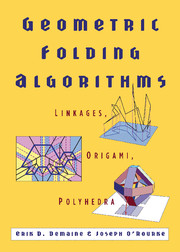21 - Introduction and Overview
Published online by Cambridge University Press: 07 September 2010
Summary
OVERVIEW
In 1525 the painter and printmaker Albrecht Dürer published a book, Underweysung der Messung (later translated as “The Painter's Manual”), in which he explained the methods of perspective, which he had just learned himself on a trip to Italy (see Figure 21.1).
Dürer's book includes a description of many polyhedra, which he presented as surface unfoldings, are now called “nets.” For example, Figure 21.2 shows his net for a cuboctahedron. Even when he drew a more complex net, such as that for a truncated icosahedron (the shape of a soccer ball; Figure 21.3), he always chose an unfolding that avoided self-overlap. Although there is no evidence that Dürer distilled this property into a precise question, it is at least implicit in the practice of subsequent generations that every convex polyhedron may be so unfolded. More precisely, define an edge unfolding as a development of the surface of a polyhedron to a plane, such that the surface becomes a flat polygon bounded by segments that derive from edges of the polyhedron. One may view such an unfolding as obtained by slicing the surface along a collection of edges. We would like an unfolding to possess three characteristics, enjoyed by all Dürer's drawings:
The unfolding is a single, simply connected piece.
The boundary of the unfolding is composed of (whole) edges of the polyhedron, that is, the unfolding is a union of polyhedron faces.
The unfolding does not self-overlap, that is, it is a “simple polygon.”
Information
- Type
- Chapter
- Information
- Geometric Folding AlgorithmsLinkages, Origami, Polyhedra, pp. 299 - 305Publisher: Cambridge University PressPrint publication year: 2007
Accessibility standard: Unknown
Why this information is here
This section outlines the accessibility features of this content - including support for screen readers, full keyboard navigation and high-contrast display options. This may not be relevant for you.Accessibility Information
- 2
- Cited by
